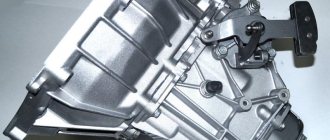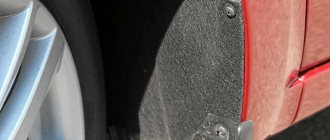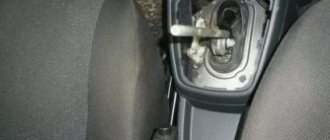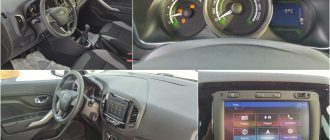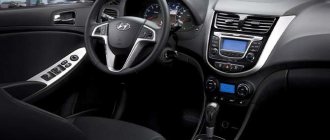The Lada Granta uses both automatic and manual transmissions. For long transmission life, it is necessary to observe maintenance intervals and not place significant overloads on the power transmission.
Mechanics are less sensitive to the quality of lubrication than automatic transmissions. Despite this, both gearboxes require timely oil changes, which is easy to do with your own hands.
Otherwise, the transmission will be subject to increased wear and tear and will fail at an accelerated rate.
Use of automatic transmission on Lada Granta cars
The Lada Granta uses a four-speed automatic transmission Jatco JF414E (AY-K3). The unit is a classic automatic transmission with a torque converter and electronic control. For optimal operation of the automatic transmission paired with the power unit, the Austrian company AVL was involved in the project.
Automatic gearbox Jatco JF414E (AY-K3)
The automatic transmission has a torque converter locking mode. It turns on when the car is moving in third or fourth gear. This mode allows you to increase the efficiency of the unit and reduce fuel consumption.
The automatic transmission received the best reviews from owners for its electronic protection against accidental or erroneous activation. The unit does not respond to the selector being moved to another position if this could damage the box. Thus, thanks to this protection, the car owner can engage a lower gear or reverse gear in advance.
The Jatco JF414E automatic transmission has overheating protection. It is triggered if the transmission oil reaches a temperature of 114°C. When overheating occurs, a gear on the instrument panel lights up, informing the driver. At the same time, the Lada Granta can continue to move, despite the increased temperature of the gearbox.
To extend service life, it is recommended to warm up the automatic transmission during subzero temperatures. To do this, move the selector several times to different positions while the power unit is running. At the same time, electronic protection prevents the transition to fourth gear. When the oil is cold, overdrive will only turn on when the speed reaches more than 70-75 km/h.
A special feature of the automatic transmission is the presence of its own electronic automatic control unit. It is located on the left under the headlight. The module constantly interacts with the engine ECU and other components. Only the parking mode is mechanically activated in the Jatco JF414E. However, it is not recommended to use this position on roads with a steep slope without applying the parking brake.
Robotic gearbox
The robotic gearbox replaced the 4-speed Jatco automatic transmission; manual transmission has been installed on the Grant since the beginning of spring 2015.
The basis of the mechanical part of the new AMT 2182 was the 2180 gearbox; instead of cables, as well as the standard pedal and clutch unit for “mechanics,” an electromechanical gearbox drive (mechatronics) from the German company ZF was installed here.
The robotic gearbox is only paired with a VAZ-21127 106 hp engine. s., the most powerful power unit installed on the Lada Granta.
The manual transmission can operate not only in automatic, but also in manual mode; there are a total of five gears in the box.
A car with AMT 2182 has become more economical than with an automatic transmission, the dynamics have also improved, and gasoline consumption has decreased.
Typical problems of a robotic gearbox.
The robotic gearbox is based on the 2180 transmission, so it does not have such a strong hum as the 2181 manual transmission.
However, in first and second gears, slight howls are observed, although after running in a new car, the noise may disappear.
Grant's gearbox may behave inappropriately - when driving in first gear and sharply pressing the accelerator pedal, second speed does not always engage, and a “slip” occurs.
A characteristic disadvantage of a manual transmission is jerks and jolts when changing gears; if the movement is dynamic, this unpleasant phenomenon is not observed during quiet driving.
But you can use the manual mode, and then the manual transmission practically becomes a “mechanics”.
Review of manual transmission on Lada Granta
Initially, the Lada Granta was equipped with an intermediate manual transmission model 2190. It can be found on cars manufactured in 2011-2013. The transmission turned out to be extremely unsuccessful, so it was almost immediately replaced by the new model 2181.
The main disadvantages of the 2190 gearbox include low reliability and increased vibration. The box makes a lot of noise, and the clarity of gear shifting leaves much to be desired. Over time, it becomes more and more difficult to switch gears.
Oil leaks often appear on the 2190 box. Ignoring them leads to increased wear of gears and synchronizers.
Manual transmission VAZ 2190
Realizing the failure of the VAZ 2190 transmission, management set the engineers the task of developing a new manual transmission. Box 2180 was taken as the basis. The new unit was named 2181.
Transmission 2181 is a manual transmission with cable drive. This design solution made it possible to reduce the level of vibration in the body. Gear shifting has become much clearer. The car owner no longer needs to search for the desired lever position.
A significant drawback of the 2181 gearbox of the first releases was that the gearbox made a noticeable howl when the car was moving. The company had to respond to a huge number of complaints about car owners. Box 2181 has been modified. Its modernized version with improved technology for processing gears and shafts appeared on assembly lines in the summer of 2014.
In manual transmission 2181 it was necessary to increase the clutch diameter to 215 mm. This affected the location of the starter. It was moved from the box to the engine. The crankcase also needed to be replaced.
What gearboxes did it come with?
The Lada Granta passenger car has been in mass production since March 2011; this model replaced the popular Samara series.
Initially, the car was equipped only with a VAZ-2180 five-speed manual transmission; later, automatic and robotic gearboxes were installed on the car.
The cable manual gearbox Lada Granta with index 2181 has been produced since October 2012; it was later modernized, since car owners had many quality complaints about it.
Each type of transmission installed on a Togliatti-made car has its own characteristic differences and weaknesses, the so-called “diseases”.
Main technical characteristics
The technical characteristics of the Lada Granta are directly related to which engine and gearbox are installed on the car. More detailed information about the main parameters of the car is given in the tables below.
Table - Fuel consumption with automatic transmission when driving in a mixed cycle
| Engine | Consumption, l |
| 1.6 l 8-cl., 87 hp | 7.7 |
| 1.6 l 16-cl., 98 hp | 7.6 |
Real fuel consumption, according to reviews from car owners, differs significantly from the gasoline consumption declared by the manufacturer. Drivers complain that the Lada Granta in mixed mode consumes up to 12-14 liters of gasoline per 100 km. For cars with manual transmission, no significant difference in fuel consumption compared to the declared technical characteristics was found.
Gearbox selection
All types of gearboxes on the Lada have their advantages and disadvantages, but even the domestically assembled Grant gearboxes do not cause very big problems for car owners.
If we do not take into account the slight noise of the mechanical part of the transmission, then we can say that the “robot” and “mechanics” are quite reliable, without pronounced characteristic “diseases”.
For those who like a leisurely drive and comfortable driving, an automatic transmission is best; there is only one drawback - increased gas consumption.
Although the manual transmission whines, the noise does not particularly affect its service life; during normal operation, it can travel about two hundred thousand kilometers without problems.
The electronics in the robotic box sometimes malfunction, and you need to get used to the specifics of driving a car with AMT.
Which transmission to choose for the Lada Granta is a personal matter for each motorist; a lot here depends on the preferences of the driver himself.
Automatic transmission reliability and service life
The Jatco JF414E hardware design is simplified as much as possible, which reduces the risk of difficult-to-fix problems. Still, the machine is not without “childhood diseases” that manifest themselves during the running-in stage. The needle bearing of the pump hub is clamped until it is completely destroyed. Car owners often encounter this problem with a mileage of 6-15 thousand km.
The design of the Jatco JF414E assumes a fairly large margin of safety. The box can serve 200-400 thousand km without major repairs. The service life of an automatic transmission is usually exhausted after a million kilometers. In this case, the unit requires a complete overhaul and major overhaul.
The electronic control unit may fail after a mileage of 150-200 thousand km. The main cause of failure is external influence. The risk of firmware damage is extremely low.
The central double-row bearing often fails after a mileage of 60-130 thousand km. It usually breaks down due to overloads caused by driving with vibrations at high speeds.
Oil seals begin to leak after a mileage of more than 90 thousand km. This is often due to the use of oil that is not suitable for specific climate conditions.
The entire hydraulic unit rarely fails. Its replacement may be required when the mileage exceeds 400-500 thousand km. At the same time, at a mileage of 70-100 thousand km, gaskets and solenoids may need to be replaced. This is usually caused by dirty oil and frequent overheating. With a mileage of more than 120 thousand km, it may be necessary to install new sensors due to their damage by steel chips in contaminated oil.
Some car owners are faced with the problem of damage to the pan body. It can get crushed from being hit by a stone, despite the presence of underbody protection and decent ground clearance of the Lada Grant.
Clutches wear out depending on the aggressiveness of your driving style. Their replacement under normal conditions is required when reaching 150-250 thousand km. It is also advisable to install new Teflon rings during repairs.
Tips for use
But no matter how unpretentious this transmission may be, it is necessary to operate it, like any other thing, correctly.
There are certain rules that any owner of a car with a Jatko automatic must adhere to:
- Checking the level and changing the oil.
- Correct driving.
- Proper towing.
Proper driving with Jatco automatic transmission
The Jatko automatic transmission is reliable and durable. The key feature is the ease and smoothness of gear shifting. But in any case, it is recommended to warm up the car before driving in winter. And in the summer - cool.
No need to pull the shift knob. The automatic transmission itself adapts to your driving style. The driver only needs to enjoy the ride with this transmission. And also the automatic does not like long driving at high speed.
Towing a car
In order to tow a car with a Jatco automatic, the following recommendations should be followed:
- Tow for a distance of no more than 40 km.
- Do not exceed the speed when towing – 35 km/h.
- Move the transmission rocker to the neutral position.
- Avoid jerking when towing. This may render the Jatco automatic transmission unusable.
Read
DIY diagnostics and repair of Audi automatic transmission
Shift modes: gear shifter
As with all cars with an automatic transmission, Jatco has the following rocker positions:
- P – parking;
- N – neutral;
- D – forward movement;
- R – backward movement;
- 1 – movement only at first speed;
- 2 – start moving in 1st gear, then automatically switch from first to second gear. The automatic transmission will not accelerate the car beyond 2nd gear.
The model is also equipped with “M” mode – mechanical. The driver will be able to independently increase or decrease gears. And it has “A” - automatic mode. Switching will occur using an actuator block.
Review of feasibility of repairs
The manual transmission and automatic transmission of the Lada Granta have good maintainability. The mileage between major repairs is 250-400 thousand km.
Purchasing a new or contract transmission is advisable if the mileage of the original unit has exceeded a million km. Also, the purchase is justified if the installed unit has severe deformations caused by overheating or significant mechanical stress. The cost of a new manual transmission is 26-333 thousand rubles. For the contract option you will need to pay from 12 thousand rubles. A new machine costs 50-65 thousand rubles. Prices for a contract automatic transmission start from 18 thousand rubles.
Slightly updated interior
We have talked about the Granta salon more than once. There are not many changes in the updated version. The designers redesigned the instrument panel; as a result, the gearbox operation indication has moved and is now displayed above the fuel reserve scale. The shelf on the front panel on the passenger side disappeared from view. Now it is covered by the glove compartment lid. But for some reason the lid of the convenient drawer at the top of the panel is made of plastic in the wrong color, which causes slight irritation. A 12V socket took the place of the cigarette lighter.
There are also nice little things - three headrests in the back row, for example. They are not very high and do not interfere with the view to the rear through the interior mirror. There are hooks on the handles under the ceiling. There is a belt for the middle passenger with a well-thought-out fastening. True, it’s uncomfortable to sit in the back - the Granta remains a cramped car. Only a child or a miniature adult can fit behind the driver. There is a hum in the cabin, which, of course, is annoying. We can only hope that this is a feature of the Grant with its 98-horsepower engine.
Required tools for changing automatic transmission oil
To change the automatic transmission oil, you need the tools from the list below.
Table - Tools and materials required for changing the oil in the machine
| Tools and materials | Note |
| Capacity | Container for draining old oil |
| Watering can | With a piece of hose |
| Rags | Lint-free |
| Socket wrench or socket | "at 10", "at 19" |
| Hexagon | "by 5" |
| Ratchet | With extension |
Jatco box design
The design of the Jatco automatic transmission, like other transmissions, consists of:
- torque converter;
- planetary part;
- valve body
Torque converter
The torque converter is both the clutch and the fluid coupling of the Jatco box. It converts torque from the engine and transmits it to the input shaft.
Planetary gear
Planetary gear includes:
Read
How to check an automatic transmission torque converter: main symptoms of a malfunction
- sun gear;
- satellites that are attached to the planetary carrier;
- clutch;
- band brake.
Clutches and steel discs
The automatic transmission's clutches and steel discs serve as elements for engaging the clutch and transmitting torque. Essentially, friction clutches are steel discs, only friction tape is glued onto them. Pressing against the steel discs, the clutches connect the two rotating shafts of the automatic transmission.
All this is controlled by a computer, and the hydraulic unit presses on the pistons of the drums, squeezing the clutches in shifts.
Hydraulic unit
The automatic transmission valve body of the 414 e model is reliable and rarely fails. Most often, the owner has to replace solenoids. They are a consumable element of the transmission.
List of necessary tools for changing oil in manual transmission
To change the oil in a manual transmission, the tools from the table below are required.
Table - Tools and materials required to change the oil in a manual transmission
| Tools and materials | Note |
| Ratchet | Narrow |
| Heads | "at 17", "at 19" |
| Key | "at 13", "at 17", "at 19" |
| Special tool for filling oil | Oil resistant syringe |
| Rags | To clean dirt |
Is it difficult to engage manual transmission gears when cold? clutch? Grade:
#2 Nord
- Group: Sitrovod
- Posts: 7065
- Registration: 13 September 06
- City: Samara-city
- Gender: Man
- Car: C4 Picasso 2.0i Confort Nocciola ———————- C4 5d 1.6 Iridis before
#3 mechanik2010
- Topic author
Post edited by Nord: 11 October 2010 — 16:13
#4 Buntar
- Group: Sitrovod
- Posts: 156
- Registration: 27 November 09
- Chelyabinsk city
- Gender: Man
- Car: C5-II 2006 EW10A (RFJ) manual transmission
Post edited by Buntar: 26 August 2010 — 12:07
#5 tarakan67
- Group: Sitrovod
- Posts: 651
- Registration: 04 December 08
- City: Saki Crimea
- Gender: Man
- Car: Citroen C5-1
mechanik2010 (26.8.2010, 11:16) wrote:
Post edited by Nord: 26 August 2010 — 15:04
#6 Tsepyatich
- Group: Sitrovod
- Posts: 922
- Registration: 02 August 07
- City: Dolgoprudny
- Car: Citroen C5 1, born in 2004, silver manual
#8 smith
mechanik2010 (26.8.2010, 11:35) wrote:
“Soured” drive cables for the C5-1 gearbox are a standard problem. In winter it is simply more noticeable. Mine didn’t even get through 80k on the first C5. By the way, the release lever also buzzed a little early, but it completely jammed, I remember, by 95k..
#9 AlexDav
- Group: Sitrovod
- Posts: 288
- Registration: 03 December 07
- City: St. Petersburg
- Car: GAZ 3110, S-5II, 2.0, REN, 2006, manual transmission.
mechanik2010 (26.8.2010, 11:16) wrote:
#10 SERGIO1987
- Group: Sitrovod
- Posts: 233
- Registration: 02 December 08
- City: Kirov
- Gender: Man
- Car: BX 19TZI station wagon 1990, C5 2.0i station wagon 2003
Smith (26.8.2010, 18:54) wrote:
At exactly 150 thousand, my bearing first hummed, then jammed, then one ear fell off.
As a result, when I compared the clutch removed from the car and the new original one, I didn’t notice much of a difference. The basket is almost perfect, only the release bearing has worn out its petals, the disc is just perfect, but the release bearing is just screwed. sheer
#12 mechanik2010
- Topic author
tarakan67 (26.8.2010, 14:18) wrote:
I tried it, squeezed the clutch several times, there was no backlash, the symptoms were the same. Probably the cylinder is fine and the problem is something else. Perhaps it really is the cables, although I have a hard time believing it, the car is moving, and the cables are only responsible for switching.
leonn_c5 (26.8.2010, 16:53) wrote:
Mechanical oil change
Changing the oil on manual transmission 2181 is carried out according to the instructions below.
- Unscrew the drain plug.
- Drain the oil into a container.
- Screw in the drain plug.
- Fill with fresh oil through the inspection hole.
Changing the oil on manual transmission 2190 differs from 2181. It is performed according to the algorithm below.
- Unscrew the drain plug.
- Drain the oil.
- Open the hood.
- Remove the air filter.
- Clean any dirt around the filler hole.
- Unscrew the dipstick.
- Add oil.
- Check the lubricant level.
- Reinstall the air filter.
The filling volumes of manual transmissions 2190 and 2181 are different.
If you have a mechanic
Gears shift poorly in a car with a manual transmission for three reasons. The first of these is a malfunction of the clutch when it does not completely disengage (drive). The first sign of this malfunction is that the reverse gear is engaged with a characteristic crash. The rear one reacts to this anomaly more noticeably than other gears, because it is the only one not equipped with a synchronizer.
The second reason is a defect in the gear selection mechanism of the gearbox. And finally, the third is excessive wear of the gearbox synchronizers.There are also several clutch malfunctions in which manual transmission gears shift poorly:
- Air in the clutch release hydraulic drive or fluid leakage from it. The malfunction is eliminated by replacing failed components of the hydraulic system and pumping it.
- Worn or broken clutch release fork. The part requires replacement or repair.
- Warping (runout greater than 0.5 mm) or too thick new driven disk.
- Failure of the basket (temperature deformation of the pressure plate or its distortion).
- Loss of mobility of the support bearing of the gearbox input shaft (at the end of the crankshaft to which the flywheel is attached).
- Jamming of the clutch driven disc hub on the splines of the gearbox input shaft. To eliminate the defect, clean the splines of the gearbox hub and input shaft. It wouldn’t hurt to lubricate them a little with lithol.
- There is too much free play in the clutch release fork. Its value needs to be clarified with the manufacturer, since it is slightly different for different cars. Until you find out the value of this parameter for your car, set it from 5 to 8 mm. Too little free play of the fork is also undesirable, as it leads to clutch slipping and increased wear of the release bearing.
Excessive wear of synchronizers mainly occurs in those gears that are engaged more often: these are usually first, second and third. The rear one is not included in this list because it does not have a synchronizer. When your gear shifts poorly, and you assume that the reason for this is wear of the synchronizers, firstly, you should only have difficulties with this while driving. Secondly, in this case it switches better if you use double squeeze.
For those who don’t know what double squeeze is. To shift to a higher gear: depress the clutch, engage neutral, release and depress the clutch again, engage the gear.
Backlash in the so-called “helicopter” is one of the reasons for unclear gear shifting
To switch to a lower gear: double squeezing must be combined with re-engaging, that is, when the clutch pedal is released and the gearbox is in neutral, you need to press and release the accelerator pedal. This is how gears are changed in cars that do not have synchronizers. If the gearbox shifts easier using double squeezing, then the culprit for poor gear shifting is most likely worn synchronizers.
Look for damage or check that it is adjusted correctly. Don't even think about the clutch and synchronizers.
Description of winter mode “W”
The most popular among car enthusiasts is an additional program called “winter mode”.
Possible winter mode designations:
When using this program, the car on a snowy track starts moving in second gear without slipping. Subsequent gear changes are made at lower engine speeds. This is designed to avoid sudden skidding and acceleration of the car. In summer, this program is not used, because in “Winter” the automatic transmission receives additional heating due to increased loads. At subzero ambient temperatures, the oil in the transmission cools quickly, so additional heating does not pose a threat to the transmission.
It is not advisable to use the “Snow” mode when driving on clean highways inside the city, where there is relatively good coverage. It is more in demand for driving on dirt country roads in winter conditions. The most dangerous use of the winter program is when the car is slipping. It is recommended to avoid places where the car’s wheels can get stuck (slippery areas under loose snow, deep puddles on dirt roads, etc.).


